中国低碳经济的发展【外文翻译】
- 格式:doc
- 大小:84.50 KB
- 文档页数:16
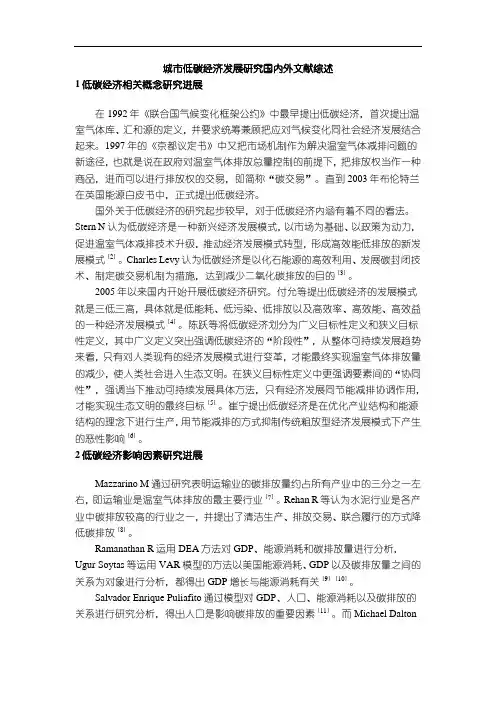
城市低碳经济发展研究国内外文献综述1低碳经济相关概念研究进展在1992年《联合国气候变化框架公约》中最早提出低碳经济,首次提出温室气体库、汇和源的定义,并要求统筹兼顾把应对气候变化同社会经济发展结合起来。
1997年的《京都议定书》中又把市场机制作为解决温室气体减排问题的新途径,也就是说在政府对温室气体排放总量控制的前提下,把排放权当作一种商品,进而可以进行排放权的交易,即简称“碳交易”。
直到2003年布伦特兰在英国能源白皮书中,正式提出低碳经济。
国外关于低碳经济的研究起步较早,对于低碳经济内涵有着不同的看法。
Stern N认为低碳经济是一种新兴经济发展模式,以市场为基础、以政策为动力,促进温室气体减排技术升级,推动经济发展模式转型,形成高效能低排放的新发展模式[2]。
Charles Levy认为低碳经济是以化石能源的高效利用、发展碳封闭技术、制定碳交易机制为措施,达到减少二氧化碳排放的目的[3]。
2005年以来国内开始开展低碳经济研究。
付允等提出低碳经济的发展模式就是三低三高,具体就是低能耗、低污染、低排放以及高效率、高效能、高效益的一种经济发展模式[4]。
陈跃等将低碳经济划分为广义目标性定义和狭义目标性定义,其中广义定义突出强调低碳经济的“阶段性”,从整体可持续发展趋势来看,只有对人类现有的经济发展模式进行变革,才能最终实现温室气体排放量的减少,使人类社会进入生态文明。
在狭义目标性定义中更强调要素间的“协同性”,强调当下推动可持续发展具体方法,只有经济发展同节能减排协调作用,才能实现生态文明的最终目标[5]。
崔宁提出低碳经济是在优化产业结构和能源结构的理念下进行生产,用节能减排的方式抑制传统粗放型经济发展模式下产生的恶性影响[6]。
2低碳经济影响因素研究进展Mazzarino M通过研究表明运输业的碳排放量约占所有产业中的三分之一左右,即运输业是温室气体排放的最主要行业[7]。
Rehan R等认为水泥行业是各产业中碳排放较高的行业之一,并提出了清洁生产、排放交易、联合履行的方式降低碳排放[8]。
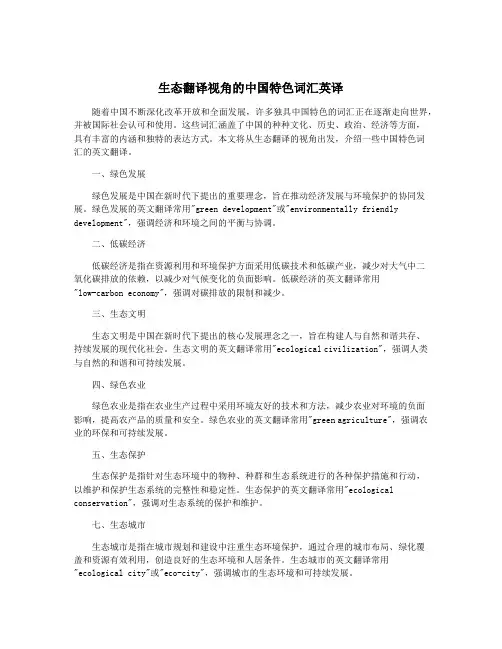
生态翻译视角的中国特色词汇英译随着中国不断深化改革开放和全面发展,许多独具中国特色的词汇正在逐渐走向世界,并被国际社会认可和使用。
这些词汇涵盖了中国的种种文化、历史、政治、经济等方面,具有丰富的内涵和独特的表达方式。
本文将从生态翻译的视角出发,介绍一些中国特色词汇的英文翻译。
一、绿色发展绿色发展是中国在新时代下提出的重要理念,旨在推动经济发展与环境保护的协同发展。
绿色发展的英文翻译常用"green development"或"environmentally friendly development",强调经济和环境之间的平衡与协调。
二、低碳经济低碳经济是指在资源利用和环境保护方面采用低碳技术和低碳产业,减少对大气中二氧化碳排放的依赖,以减少对气候变化的负面影响。
低碳经济的英文翻译常用"low-carbon economy",强调对碳排放的限制和减少。
三、生态文明生态文明是中国在新时代下提出的核心发展理念之一,旨在构建人与自然和谐共存、持续发展的现代化社会。
生态文明的英文翻译常用"ecological civilization",强调人类与自然的和谐和可持续发展。
四、绿色农业绿色农业是指在农业生产过程中采用环境友好的技术和方法,减少农业对环境的负面影响,提高农产品的质量和安全。
绿色农业的英文翻译常用"green agriculture",强调农业的环保和可持续发展。
五、生态保护生态保护是指针对生态环境中的物种、种群和生态系统进行的各种保护措施和行动,以维护和保护生态系统的完整性和稳定性。
生态保护的英文翻译常用"ecological conservation",强调对生态系统的保护和维护。
七、生态城市生态城市是指在城市规划和建设中注重生态环境保护,通过合理的城市布局、绿化覆盖和资源有效利用,创造良好的生态环境和人居条件。
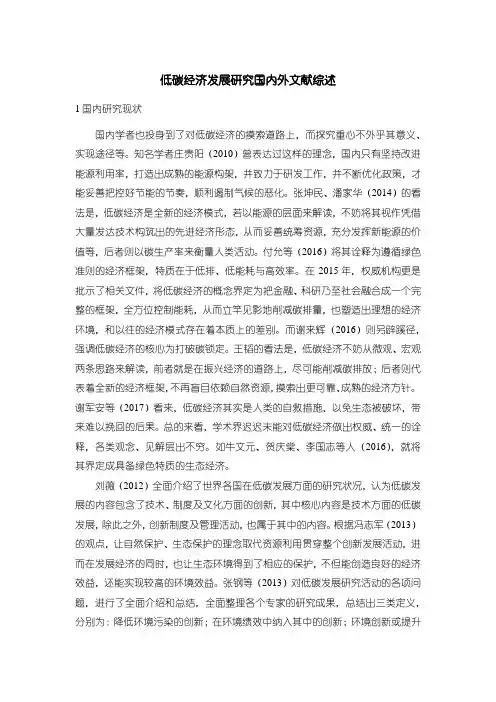
低碳经济发展研究国内外文献综述1国内研究现状国内学者也投身到了对低碳经济的摸索道路上,而探究重心不外乎其意义、实现途径等。
知名学者庄贵阳(2010)曾表达过这样的理念,国内只有坚持改进能源利用率,打造出成熟的能源构架,并致力于研发工作,并不断优化政策,才能妥善把控好节能的节奏,顺利遏制气候的恶化。
张坤民、潘家华(2014)的看法是,低碳经济是全新的经济模式,若以能源的层面来解读,不妨将其视作凭借大量发达技术构筑出的先进经济形态,从而妥善统筹资源,充分发挥新能源的价值等,后者则以碳生产率来衡量人类活动。
付允等(2016)将其诠释为遵循绿色准则的经济框架,特质在于低排、低能耗与高效率。
在2015年,权威机构更是批示了相关文件,将低碳经济的概念界定为把金融、科研乃至社会融合成一个完整的框架,全方位控制能耗,从而立竿见影地削减碳排量,也塑造出理想的经济环境,和以往的经济模式存在着本质上的差别。
而谢来辉(2016)则另辟蹊径,强调低碳经济的核心为打破碳锁定。
王韬的看法是,低碳经济不妨从微观、宏观两条思路来解读,前者就是在振兴经济的道路上,尽可能削减碳排放;后者则代表着全新的经济框架,不再盲目依赖自然资源,摸索出更可靠、成熟的经济方针。
谢军安等(2017)看来,低碳经济其实是人类的自救措施,以免生态被破坏,带来难以挽回的后果。
总的来看,学术界迟迟未能对低碳经济做出权威、统一的诠释,各类观念、见解层出不穷。
如牛文元、贺庆棠、李国志等人(2016),就将其界定成具备绿色特质的生态经济。
刘薇(2012)全面介绍了世界各国在低碳发展方面的研究状况,认为低碳发展的内容包含了技术、制度及文化方面的创新,其中核心内容是技术方面的低碳发展,除此之外,创新制度及管理活动,也属于其中的内容。
根据冯志军(2013)的观点,让自然保护、生态保护的理念取代资源利用贯穿整个创新发展活动,进而在发展经济的同时,也让生态环境得到了相应的保护,不但能创造良好的经济效益,还能实现较高的环境效益。
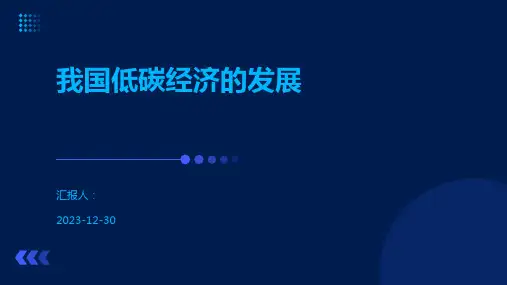
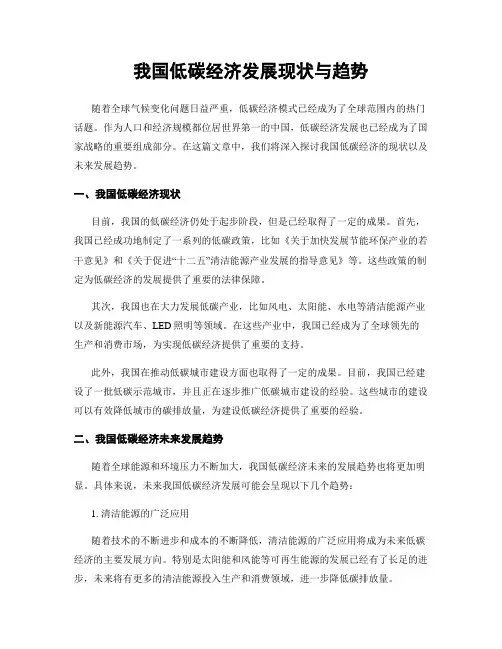
我国低碳经济发展现状与趋势随着全球气候变化问题日益严重,低碳经济模式已经成为了全球范围内的热门话题。
作为人口和经济规模都位居世界第一的中国,低碳经济发展也已经成为了国家战略的重要组成部分。
在这篇文章中,我们将深入探讨我国低碳经济的现状以及未来发展趋势。
一、我国低碳经济现状目前,我国的低碳经济仍处于起步阶段,但是已经取得了一定的成果。
首先,我国已经成功地制定了一系列的低碳政策,比如《关于加快发展节能环保产业的若干意见》和《关于促进“十二五”清洁能源产业发展的指导意见》等。
这些政策的制定为低碳经济的发展提供了重要的法律保障。
其次,我国也在大力发展低碳产业,比如风电、太阳能、水电等清洁能源产业以及新能源汽车、LED照明等领域。
在这些产业中,我国已经成为了全球领先的生产和消费市场,为实现低碳经济提供了重要的支持。
此外,我国在推动低碳城市建设方面也取得了一定的成果。
目前,我国已经建设了一批低碳示范城市,并且正在逐步推广低碳城市建设的经验。
这些城市的建设可以有效降低城市的碳排放量,为建设低碳经济提供了重要的经验。
二、我国低碳经济未来发展趋势随着全球能源和环境压力不断加大,我国低碳经济未来的发展趋势也将更加明显。
具体来说,未来我国低碳经济发展可能会呈现以下几个趋势:1. 清洁能源的广泛应用随着技术的不断进步和成本的不断降低,清洁能源的广泛应用将成为未来低碳经济的主要发展方向。
特别是太阳能和风能等可再生能源的发展已经有了长足的进步,未来将有更多的清洁能源投入生产和消费领域,进一步降低碳排放量。
2. 数字经济与低碳经济的融合数字经济是一个新的经济形态,它将信息、网络、技术等与传统经济生产、流通和消费等紧密结合。
数字经济的发展将为低碳经济提供有力的支持。
未来数字经济与低碳经济将逐渐融合,通过信息化和数字化技术来促进低碳经济的发展。
3. 绿色金融的发展绿色金融是指以满足可持续发展为目的的金融活动。
随着社会对环保意识的提高,绿色金融在未来将得到进一步发展。
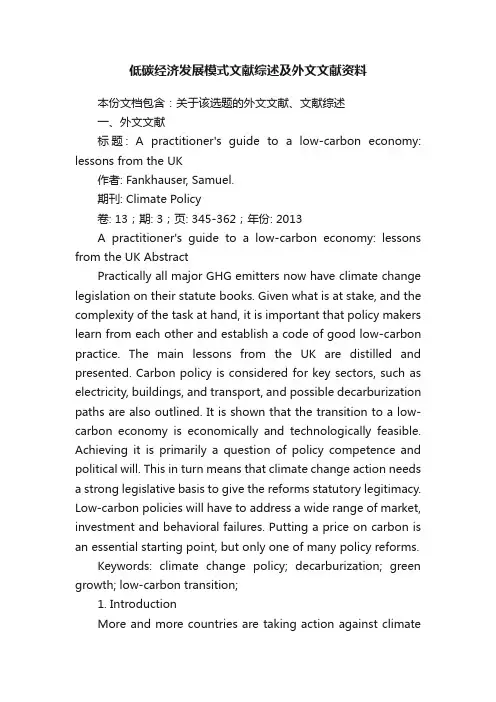
低碳经济发展模式文献综述及外文文献资料本份文档包含:关于该选题的外文文献、文献综述一、外文文献标题: A practitioner's guide to a low-carbon economy: lessons from the UK作者: Fankhauser, Samuel.期刊: Climate Policy卷: 13;期: 3;页: 345-362;年份: 2013A practitioner's guide to a low-carbon economy: lessons from the UK AbstractPractically all major GHG emitters now have climate change legislation on their statute books. Given what is at stake, and the complexity of the task at hand, it is important that policy makers learn from each other and establish a code of good low-carbon practice. The main lessons from the UK are distilled and presented. Carbon policy is considered for key sectors, such as electricity, buildings, and transport, and possible decarburization paths are also outlined. It is shown that the transition to a low-carbon economy is economically and technologically feasible. Achieving it is primarily a question of policy competence and political will. This in turn means that climate change action needs a strong legislative basis to give the reforms statutory legitimacy. Low-carbon policies will have to address a wide range of market, investment and behavioral failures. Putting a price on carbon is an essential starting point, but only one of many policy reforms.Keywords: climate change policy; decarburization; green growth; low-carbon transition;1. IntroductionMore and more countries are taking action against climatechange. Nearly all major GHG emitters, including many emerging markets, now have climate change legislation on their statute books (Town- shend et ak, 2011). It is debatable whether these efforts - and any international agreement that might reinforce them - will be sufficient to limit climate change to an acceptable level. However, given what is at stake, and the complexity of the task at hand, it is important that policy makers learn from one another and establish a code of good low-carbon practice. This article attempts to distil the main lessons from the UK.The climate change debate in the UK is fairly advanced, with a strong legal basis for climate action, ambitious targets, and sophisticated institutional arrangements (Fankhauser, Kennedy, & Skea, 2009). The UK also has a constantly evolving regulatory landscape, with occasional policy failures and U- turns, while a waning commitment among politicians and latent climate scepticism in parts of the press are putting the institutional framework increasingly to the test. As such, the UK is a good case from which to learn lessons.1There is a rich analytical literature on many aspects of climate change policy. For example, much has been written about the relative merit of different policy options (Hepburn, 2006; Pizer, 2002), the design of emissions trading schemes (Fankhauser & Hepburn, 2010a, 2010b; Grüll & Taschini, 2011; Murray, Newell, & Pizer, 2009),policy performance (Ellerman & Buchner, 2008; Ellerman, Convery, de Perthuis, & Alberola, 2010; Martin, Preux, & Wagner, 2009), and low-carbon innovation (Acemoglu, Aghion, Bursztyn, & Heinous, 2009; Aghion, Boulanger, & Cohen, 2011; Aghion, Dechezleprêtre, Heinous, Martin, & van Reenen, 2011; Dechezleprêtre, Glachant, Hascic, Johnstone, & Ménière, 2011;Popp, 2002).This article differs from the existing literature in that it takes an explicitly practical approach. While drawing on the analytical literature, it looks at the specific case of a country that wants to reduce its GHG emissions, in this case the UK. The policy ambition is much deeper than a marginal change in emissions, which is the concern of much of the literature. It is a comprehensive redesign of the modern economy. At the same time, the scope is narrower than that of the green growth literature, which includes wider notions of sustainable development besides low-carbon growth (Bowen & Fan- khauser, 2011). All decarburization efforts will face at least four challenges. First, a strong legal and institutional basis for low-carbon policy must be put in place (Section 2). Second, low-carbon objectives must be translated into a credible roadmap of sector, technology, and reform targets that can guide policy and determine whether the objectives are achievable (Section 3). Third, the necessary policies to implement the roadmap must be put in place (Section 4). Fourth, the wider socio-economic conse- quences of decarburization must be managed (Section 5). It is concluded in Section 6 that the low- carbon transition is achievable if these challenges are met and there is sufficient policy competence and political will.2. Providing the legal and institutional basisThe starting point for economy-wide decarburization is a strong legislative basis. The fundamental reforms to energy, transport, industrial, agricultural, and fiscal policy that will follow will need statu- tory legitimacy. The adoption of a climate change law is also a way of forging the broad political con- sensus needed during implementation. It is striking how many of the climate change laws in major economies have been bipartisanefforts (Townshend et ak, 2011). The UK Climate Change Act of 2008, for example, was passed near-unanimously.Most climate change laws are unifying laws that bring together existing strands of regulation (e.g. on energy efficiency), express a long-term objective, and create a platform for subsequent action. The UK Climate Change Act calls for a cut in GHG emissions of at least 80%, relative to 1990, by 2050. This is based on an ambition to limit median global warming to 2°C and keep the risk of extreme climate change (of say 4°C) to a minimum. The Act also defines the mechanism through which the long- term target is to be met: a series of statutory, 5-year carbon budgets that set a binding ceiling for GHG emissions over that period. The UK has been subject to this economy-wide carbon constraint since 2008.One of the key purposes of the legislation is to make a statement of intent that can subsequently guide policy delivery and reduce uncertainty for decision makers. Although action is required immedi- ately, building a low-carbon economy will take decades, a much longer term than policy makers can credibly commit. This creates problems for businesses, which will mistrust the long-term validity of the plan and hedge their behaviour. An important role of climate change legislation is to overcome such time inconsistency problems and instil long-term credibility into the policy effort.The issue is akin to the credibility of inflation targets (Kydland & Prescott, 1977; Barro & Gordon, 1983; Rogoff, 1985), and the institutional remedies that have been proposed for both problems bear some resemblance to one another. An independent institution, the Committee on Climate Change (CCC), was created to recommend and monitor carbon budgets,in the belief that technocrats are more likely to take a long-term view than politicians. However, the carbon budgets are ultimately passed by Parlia- ment to give them statutory credibility. A judicial review is likely if the government systematically ignores the Committee's advice or if key policy decisions are inconsistent with carbon objectives.3. Defining a strategy for deliveryFor the high-level objectives of the climate law to be credible they need to be backed up by a sound implementation strategy. The UK, EU, and many other jurisdictions have developed concrete decarbo- nization roadmaps for this purpose (CCC, 2010; DECC, 2011; EC, 2011). These are not blueprints that need to be implemented to the letter. The markets and private initiative will determine most of the details. However, they represent important strategies that will detennine the speed and direction of travel.These roadmaps are underpinned by a fair amount of technical analysis, which ensures that the strat- egy is technologically and economically rational, as well as consistent with the ultimate emissions objective. Numerical simulation models are well suited to the calculation of the least-cost way of meeting a certain emissions target under given technology constraints. In the UK, both the CCC and the Department of Energy and Climate Change (DECC) have used such models to inform their low-carbon roadmaps. The model evidence used by the CCC, in particular, is quite detailed. Even so, model results are heavily complemented and qualified by professional judgement.Least-cost optimization models (e.g. MARKAL) are used to determine the correct choice of technol- ogies as a function of their cost profiles (CCC, 2010), which are themselves derived fromdetailed engin- eering studies (e.g. Mott McDonald, 2011). Least-cost models also inform the allocation of scarce resources among competing uses; e.g. in determining whether the limited supply of sustainable biomass should be used for electricity generation, heating, or transport (CCC, 2011a). Detailed models of the electricity market can simulate how the power sector will cope with a rising share of inter- mittent renewables and inflexible nuclear capacity (P?yry, 2011). Least-cost models provide estimates of the likely economic costs, although these bottom-up estimates should be complemented with general equilibrium or macro-econometric model mns (Barker et ak, 2007).A key question that the roadmap should answer is about the speed of decarbonization: 'What is the most economically rational rate of bringing emissions down?' The anticipated fall in the cost of low- carbon technologies and the effect of discounting suggests that a slow start will be followed by steep emissions reductions later.2 However, progress in reducing technology costs is a function of cumulativeinvestment, not just the passage of time. Postponing low-carbon investment may therefore delay the point at which these technologies become cost-effective. Scientists can also point to the climate benefits of acting early: future climate change is determined by the sum total of emissions over time, and not their level in an arbitrary future year (Meinshausen et ak, 2009), so each year of delay imposes a social and environmental climate cost.Moreover, there are limits to the speed at which emissions may be reduced cost-effectively later. As an illustration, if carbon-intensive capital has a lifetime of 25 years, the maximum annual emissions cut that can be achieved through the regularinvestment cycle is 4%. To achieve this, all new invest- ment (in both replacement and expansionary capital) would have to be carbon-free. Going beyond 4% would require the premature scrapping of existing capital. This is expensive unless productivity improvements (e.g. through energy efficiency) are so high that an overall reduction in the capital stock is warranted. It is argued below that this is not the case.The UK debate about the speed of reducing emissions has been heavily influenced by the particular time profile of investment needed in UK power sector. A large proportion of UK power plants are due for renewal in the 2020s. This creates both an opportunity and a need to decarbonize power generation early, as the investments made in the 2020s will determine electricity emissions for many decades to come. For these reasons, the CCC has recommended a swift pace of emission reductions in the power sector and an overall abatement path that is only slightly back-loaded (see Figure 1). This decarbonization path has profound implications not just for electricity generation, but for all emitting sectors.3.1. EnergyThe decarbonization of the electricity sector is at the core of the low-carbon transition in UK and all industrialized countries, for several reasons. First, power generation is a major source of GHG emissions (see Figure 1). Second, low-carbon power generation is well-understood and feasible. A number of low- carbon options are available, including renewable energy (wind, solar, biomass, hydro, and in time perhaps even marine), nuclear energy, and the as yet unproven carbon capture and storage (CCS). Although each of these options has its challenges - related to cost (off-shore wind, perhaps nuclear), public acceptability(nuclear, onshore wind), and/or commercial availability (CCS, marine) - they provide an adequate technological basis and choice in low-carbon power generation. Third, decarbo- nized electricity has an important role to play in reducing emissions in other sectors, chief among them transport (through battery electric vehicles), residential heating (through ground source and air source heat pumps), and perhaps some parts of industry.Any combination of renewables, nuclear, and CCS will succeed in bringing down the carbon inten- sity of power production. The choice is determined by cost, environmental considerations, and issues of system operation, and different countries make this choice differently. Germany, for example, has resisted nuclear energy, but invested heavily in solar energy. The UK has emphasized wind power over solar photovoltaics, and so far has accepted nuclear power. It is putting particular emphasis on off- shore wind, which is more expensive than onshore wind but raises fewer localenvironmental concerns (Bassi, Bowen, & Bankh?user, 2012). The carbon intensity of electricity is required to fall by as much as 90% within 20 years, from over 500 gC02/kWh to 50 gC02/kWh, according to the timetable of the CCC (CCC, 2010). This tight target reduces the scope of intermediate technologies like gas, which might otherwise be attractive. Modern combined cycle gas turbines emit around 350 gC02/kWh, which is a considerable improvement on the current system average but too much in a truly low-carbon power sector. Unless fitted with CCS, future gas-fired power plants will therefore only be used spar- ingly, primarily as back-up capacity. This is a limited but important role. The combination of inter- mittent wind and baseload nuclear power creates challenges for load management,as neither is particularly flexible in responding to short-term fluctuations in demand. Gas can provide that flexibility and balance supply and demand. However, electricity market arrangements in the UK do not currently reward a mode of operation in which a plant is predominantly idle. This will have to change.Current electricity market arrangements create another obstacle to low-carbon investment. Power prices are presently determined competitively to reflect short-term operating costs. Low-carbon tech- nologies, such as nuclear and wind, typically have high capital costs and low operating costs. If they come to dominate the sector and set short-term marginal costs, market prices may fall to a level that is too low to recoup the upfront costs. In this case, further investment would stall.Reform of the electricity market has therefore become an essential prerequisite for decarbonization. After decades of liberalization, the reforms will bring about an increased role for the state. State inter- vention will be aimed, in particular, at rectifying three market failures that would otherwise prevent low-carbon investment. First, the state can put a price on carbon to internalize the climate change externality. Ideally, this would happen through a carbon tax or a stringent emissions trading scheme. The reality in the UK is somewhat more complicated. The EU Emissions Trading Scheme (EU ETS) provides only a relatively weak price signal. The UK has thus legislated a unilateral carbon price floor to strengthen this signal. While this will motivate UK emitters to abate further, it will not reduce EU-wide emissions, which con- tinue to be set by the unchanged ETS cap (Fankhauser & Hepburn, 2010a, 2010b). The price instru- ments are complemented by a regulatory measure, an emissionsperformance standard set at (a high) 450 gC02/kWh.Second, the state can promote low-carbon (in particular renewable) energy and address market fail- ures related to technology development by using the classic instruments of either renewable energy obligations or feed-in tariffs (Section 4). The UK is moving from the former system to a variation of the latter, with the introduction of contracts for differences in low-carbon energy. Smaller-scale instal- lations benefit from a straight feed-in tariff. These demand-pull measures are complemented by a mod- erate supply-push from a new green investment bank, which will offer renewable energy investors improved access to finance. An investment subsidy is available for CCS pilots, although this process has been very slow.Third, the state can focus on the need to ensure investment into back-up capacity, as discussed above. In the UK, this will be achieved through the introduction of capacitypayments. The economic merit and practical challenges of this policy mix are further discussed in Section 4.3.2. TransportSurface transport is the second most important source of GHG emissions in the UK after electricity (see Figure 1). Cars dominate transport emissions, although emissions from lorries, vans, and buses are also substantial. Rail accounts for no more than 2% of the transport total.The strategy to reduce car emissions is two-pronged. In the short term, the emphasis is on reducing the carbon intensity of conventional cars through technological improvements and providing drivers with incentives to switch to more efficient cars. The UK has adopted an EU target to reduce the carbon intensity of new cars from current figure of around 145 g/km to 95 g/kmin 2020. There is a similar target for vans.In the medium term, further efficiency improvements will have to come from new technologies (e.g. battery electric cars, plug-in electric vehicles, and perhaps fuel-cell-based vehicles). Biofuels will also play a role, with the limited amount of sustainable biofuel probably best targeted at heavy goods vehicles and aviation (where there are fewer alternatives). The CCC has calculated that 60% of new cars sold in 2030 will need to be electric (CCC, 2010), rising to 100% by 2035 for a fully electric car fleet in the late 2040s. These are very ambitious targets, which, if met, will have repercussions on elec- tricity demand and the country's refuelling infrastmcture.In comparison to technology, the role of demand-side measures will be relatively modest and insuf- ficient to reverse the growth in driving-kilometres, although it will nevertheless be important. Changes in travel behaviour, such as eco-driving, better journey planning, car sharing, and modal shift, can have a significant effect, but alterning entrenched behaviour patterns will require persistent effort (as suggested in a recent UK pilot study on 'smarter choices'; CCC, 2010).As in the power sector, a diverse set of policies are in place to encourage the transition. Arguably the most powerful - fuel duty - is primarily a fiscal measure; it accounts for almost 5% of total government income and is the most important source of indirect tax revenue after V AT (Adam & Browne, 2011). Fuel duty helps to correct a multitude of transport-related externalities. If the entire levy were treated as a carbon tax, the implicit tax rate would be over £200 per tC02 (Bowen & Rydge, 2011).In addition, other vehicle-related taxes, such as excise duty or company car tax, are differentiated by carbon efficiency.Electric cars are subsidized by up to £5000 per vehicle, while matched funding for recharging stations is provided under the Plug-In Places programme. These policies have been rela- tively effective. Since 2008, the carbon intensity of new cars in the UK has fallen by about 9%, although the uptake of electric cars is still very low.3.3. Residential buildings and industryThe buildings and industrial sectors, when combined, account for over two-thirds of UK GHG emis- sions. A large part of these are indirect emissions from electricity use, which are assigned to the power sector in carbon accounts. However, both direct and indirect emissions are important from a demand-management perspective.The initial focus for reducing residential and industry emissions is on energy efficiency. There is much debate about the potential of energy-efficiency measures that are available at low or zero econ- omic cost. In the UK, the CCC expects a 23% reduction in non-electric energy use in buildings and industry by 2020, relative to 2007, and a 13% reduction in electricity use (CCC, 2012).Over the medium term, the focus may shift from energy efficiency to renewable heat. The CCC expects the share of renewable heat to rise from the current 1% of heat demand to 12% in 2020, much of it back-loaded, as renewable heat is still relatively expensive. From the late 2020s onwards, further decarbonization will require currently expensive options such as solid wall insulation and heat pumps. Additional measures in industry are difficult and will require new emissions reduction techniques. Options include industrial CCS, process innovation, and product substitution, none of which is as yet proven.Energy-efficiency gains are notoriously elusive. There are a multitude of policy, market, and behav- ioural barriers, some of which are well understood, others less so. This is mirrored in the policy frame- work. No other aspect of UK low-carbon agenda has seen more policy experimentation, and nowhere else is the policy landscape more complex. Although regulatory measures dominate, there are price incentives in the form of a Climate Change Levy (a carbon-cum-energy tax) and the indirect effect of the EU ETS, the cost of both are passed through to end-users. Energy-intensive businesses can avoid the Climate Change Levy by entering into a voluntary Climate Change Agreement; around 50 sectors have already done so.Renewable heat is subsidized through a renewable heat incentive. The service sector has its own mechanism, the CRC Energy Efficiency scheme, which relies on a combination of reputation effects (through a performance league table) and price incentives (through a carbon tax, later to be converted into a trading scheme). Residential energy efficiency has been promoted primarily through a succes- sion of supplier obligations (which commit energy utilities to certain energy savings or carbon emis- sions targets in their client base) and the much-vaunted Green Deal, which promises easier access to energy-efficiency finance by tying loans to the energy meter rather than householders. Despite this flurry of activity, progress in increasing residential and industrial energy efficiency has been mixed (CCC, 2012).3.4. AgricultureAgriculture accounts for perhaps 10% of UK GHG emissions, most in the form of methane (CH4) and nitrous oxide (N20) (CCC, 2012). There are accounting issues, however: agricultural andland-use emis- sions are known with much less certainty than energy-related emissions. Similarly, low-GHG options for agriculture are less well understood than decarbonization in other sectors.The available evidence suggests that there is scope to reduce emissions further, e.g. through increased feed efficiency and dietary changes in livestock, the deployment of anaerobic digestion systems, and better nutrient management for crops. However, beyond these low-cost measures, deep decarbonization maybe difficult. On the supply side, further action may engender ethical and environ- mental issues (e.g. related to animal welfare and the role of genetically modified food). On the demand side,behavioural change with respect to diets is likely to be controversial (although it would have sub- stantial health benefits; see Ganten, Haines, & Souhami, 2010). It is therefore likely that agricultural emissions (together with sectors such as aviation) will account for an increasing fraction of the increas- ingly tighter carbon budgets over the longer term.Although agriculture is one of the most highly regulated sectors in the UK economy, the policy approach to agricultural decarbonization has chiefly relied on voluntary action. Opportunities to reduce emissions through adjustments in existing policies, such as the EU Nitrates Directive or the Common Agricultural Policy, have not been taken up. Consequently, emissions have primarily been reduced as a result of unrelated policies and developments. Fertilizer-related emissions, for example, have fallen significantly as a consequence of higher prices and regulation. (A similar story holds for waste management, where methane emissions havefallen sharply as a by-product of an aggressive landfill tax.)4. Designing policiesAs discussed in the previous section, policy measures to create a low-carbon economy are needed on three fronts (Stern, 2006). First, a price should be put on carbon to internalize the climate change externality. Second, low-carbon technology should be promoted by addressing externalities and market failures related to innovation. Third, carbon-efficient behaviour and investment should be encouraged, in particular to unlock the existing energy-efficiency potential.Although the emphasis is often on the carbon price, all three sets of policies are equally important. As shown in the previous section (see also Bowen & Rydge, 2011), the UK has an elaborate low-carbon policy landscape. There are measures to put a price on carbon (e.g. the EU ETS, Climate Change Levy, carbon price support), to support new technologies (e.g. renewable energy obligations, renewable heat incentives, feed-in tariffs), to provide investor confidence (e.g. electricity market reforms), to change energy-efficiency behaviour (e.g. CRC Energy Efficiency Scheme, supplier obligations), and to facilitate access to finance (e.g. Green Deal, Green Investment Bank). Despite this complexity, which itself poses challenges, independent observers have expressed doubt that the UK policy environment is sufficient to meet the targets the country has set itself (CCC, 2010).4.1. Putting a price on carbonThere are two generic ways of putting a price on carbon: taxation or an emissions trading scheme.3 There is a large body of literature, going back to Weitzman (1974), on the relative merits of the two options (see Hoel & Karp, 2001; Newell & Pizer, 2003). Most economists probably favour a carbon tax, althoughwhere there are mandatory carbon constraints (as in the UK) the traditional Weitzman argu- ment would advocate quantity-based policies.4In practice, policy makers have been swayed less by theoretical niceties than by political realities, and in most cases an emissions trading scheme is easier to implement than a carbon tax: it creates a valuable asset - emissions permits - which can be used to pacify industry. In the case of the EU ETS, the stock of permits is worth around euro20 billion a year, and handing them out for free has indeed beensufficient to secure industry buy-in. However, there has also been a backlash against the windfall profits enjoyed by carbon 'fat cats' (Sandbag, 2011). Indeed, the European Commission has found it hard to reverse the practice of free allocation. This suggests that the use of free permits should be cur- tailed as much as possible from the outset, although some will be necessary to create consensus. The EU ETS has yielded a wealth of other practical lessons, including the need to manage price fluctuations (e.g. through an auction reserve price) and the importance of competent regulation (see Ellerman et ak, 2010; Fankhauser & Hepburn, 2010a, 2010b, for a review).Even in the presence of an emissions trading scheme, most countries have complementary taxes that cover emissions outside the scheme, strengthen the price signal within it, address other externalities, or simply raise revenue. Levying taxes on top of a trading scheme will have a detrimental effect on the carbon permit price and reduce the gains from trade (Fankhauser & Hepburn, 2010a, 2010b), but there is merit in using the two instruments in parallel in different parts of the economy.The most effective way of sending a carbon price signal。
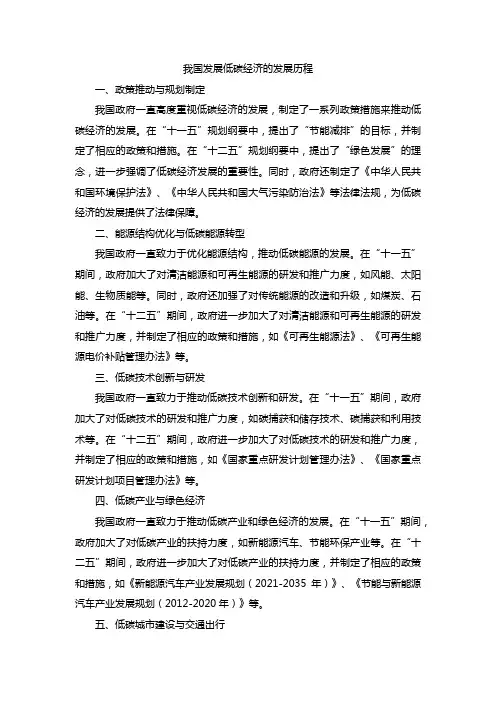
我国发展低碳经济的发展历程一、政策推动与规划制定我国政府一直高度重视低碳经济的发展,制定了一系列政策措施来推动低碳经济的发展。
在“十一五”规划纲要中,提出了“节能减排”的目标,并制定了相应的政策和措施。
在“十二五”规划纲要中,提出了“绿色发展”的理念,进一步强调了低碳经济发展的重要性。
同时,政府还制定了《中华人民共和国环境保护法》、《中华人民共和国大气污染防治法》等法律法规,为低碳经济的发展提供了法律保障。
二、能源结构优化与低碳能源转型我国政府一直致力于优化能源结构,推动低碳能源的发展。
在“十一五”期间,政府加大了对清洁能源和可再生能源的研发和推广力度,如风能、太阳能、生物质能等。
同时,政府还加强了对传统能源的改造和升级,如煤炭、石油等。
在“十二五”期间,政府进一步加大了对清洁能源和可再生能源的研发和推广力度,并制定了相应的政策和措施,如《可再生能源法》、《可再生能源电价补贴管理办法》等。
三、低碳技术创新与研发我国政府一直致力于推动低碳技术创新和研发。
在“十一五”期间,政府加大了对低碳技术的研发和推广力度,如碳捕获和储存技术、碳捕获和利用技术等。
在“十二五”期间,政府进一步加大了对低碳技术的研发和推广力度,并制定了相应的政策和措施,如《国家重点研发计划管理办法》、《国家重点研发计划项目管理办法》等。
四、低碳产业与绿色经济我国政府一直致力于推动低碳产业和绿色经济的发展。
在“十一五”期间,政府加大了对低碳产业的扶持力度,如新能源汽车、节能环保产业等。
在“十二五”期间,政府进一步加大了对低碳产业的扶持力度,并制定了相应的政策和措施,如《新能源汽车产业发展规划(2021-2035年)》、《节能与新能源汽车产业发展规划(2012-2020年)》等。
五、低碳城市建设与交通出行我国政府一直致力于推动低碳城市建设和交通出行方式的转变。
在“十一五”期间,政府加大了对城市公共交通、步行和自行车出行等低碳出行方式的推广力度。
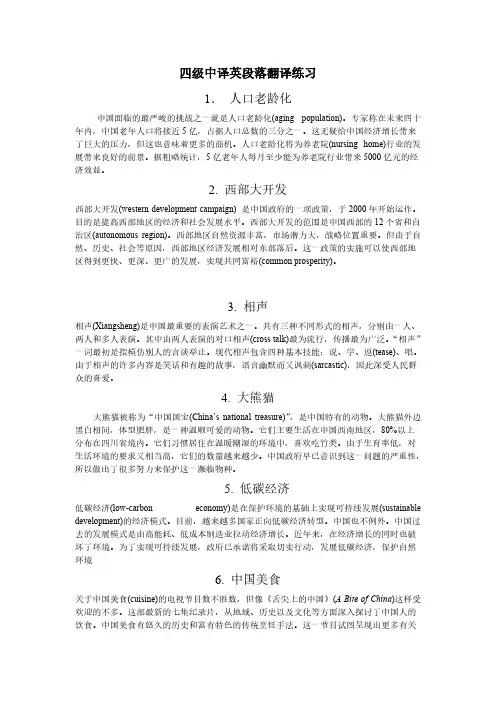
四级中译英段落翻译练习1.人口老龄化中国面临的最严峻的挑战之一就是人口老龄化(aging population)。
专家称在未来四十年内,中国老年人口将接近5亿,占据人口总数的三分之一。
这无疑给中国经济增长带来了巨大的压力,但这也意味着更多的商机。
人口老龄化将为养老院(nursing home)行业的发展带来良好的前景。
据粗略统计,5亿老年人每月至少能为养老院行业带来5000亿元的经济效益。
2. 西部大开发西部大开发(western development campaign) 是中国政府的一项政策,于2000年开始运作。
目的是提高西部地区的经济和社会发展水平。
西部大开发的范围是中国西部的12个省和自治区(autonomous region)。
西部地区自然资源丰富,市场潜力大,战略位置重要。
但由于自然、历史、社会等原因,西部地区经济发展相对东部落后。
这一政策的实施可以使西部地区得到更快、更深、更广的发展,实现共同富裕(common prosperity)。
3. 相声相声(Xiangsheng)是中国最重要的表演艺术之一。
共有三种不同形式的相声,分别由一人、两人和多人表演。
其中由两人表演的对口相声(cross talk)最为流行,传播最为广泛。
“相声”一词最初是指模仿别人的言谈举止。
现代相声包含四种基本技能:说、学、逗(tease)、唱。
由于相声的许多内容是笑话和有趣的故事,语言幽默而又讽刺(sarcastic),因此深受人民群众的喜爱。
4. 大熊猫大熊猫被称为“中国国宝(China’s national treasure)”,是中国特有的动物。
大熊猫外边黑白相间,体型肥胖,是一种温顺可爱的动物。
它们主要生活在中国西南地区,80%以上分布在四川省境内。
它们习惯居住在温暖潮湿的环境中,喜欢吃竹类。
由于生育率低,对生活环境的要求又相当高,它们的数量越来越少。
中国政府早已意识到这一问题的严重性,所以做出了很多努力来保护这一濒临物种。
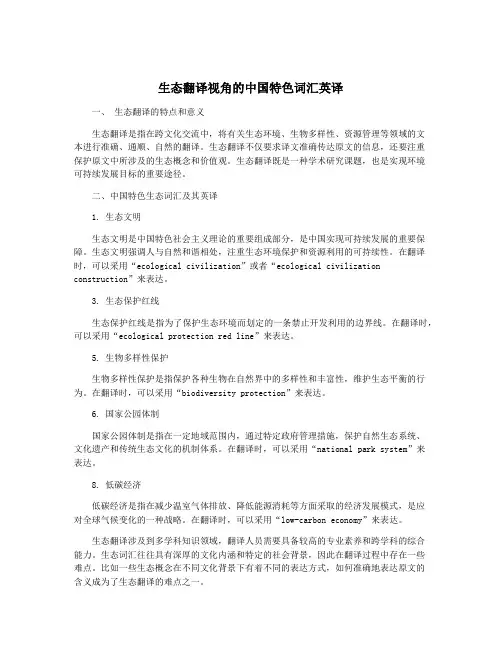
生态翻译视角的中国特色词汇英译一、生态翻译的特点和意义生态翻译是指在跨文化交流中,将有关生态环境、生物多样性、资源管理等领域的文本进行准确、通顺、自然的翻译。
生态翻译不仅要求译文准确传达原文的信息,还要注重保护原文中所涉及的生态概念和价值观。
生态翻译既是一种学术研究课题,也是实现环境可持续发展目标的重要途径。
二、中国特色生态词汇及其英译1. 生态文明生态文明是中国特色社会主义理论的重要组成部分,是中国实现可持续发展的重要保障。
生态文明强调人与自然和谐相处,注重生态环境保护和资源利用的可持续性。
在翻译时,可以采用“ecological civilization”或者“ecological civilization construction”来表达。
3. 生态保护红线生态保护红线是指为了保护生态环境而划定的一条禁止开发利用的边界线。
在翻译时,可以采用“ecological protection red line”来表达。
5. 生物多样性保护生物多样性保护是指保护各种生物在自然界中的多样性和丰富性,维护生态平衡的行为。
在翻译时,可以采用“biodiversity protection”来表达。
6. 国家公园体制国家公园体制是指在一定地域范围内,通过特定政府管理措施,保护自然生态系统、文化遗产和传统生态文化的机制体系。
在翻译时,可以采用“national park system”来表达。
8. 低碳经济低碳经济是指在减少温室气体排放、降低能源消耗等方面采取的经济发展模式,是应对全球气候变化的一种战略。
在翻译时,可以采用“low-carbon economy”来表达。
生态翻译涉及到多学科知识领域,翻译人员需要具备较高的专业素养和跨学科的综合能力。
生态词汇往往具有深厚的文化内涵和特定的社会背景,因此在翻译过程中存在一些难点。
比如一些生态概念在不同文化背景下有着不同的表达方式,如何准确地表达原文的含义成为了生态翻译的难点之一。
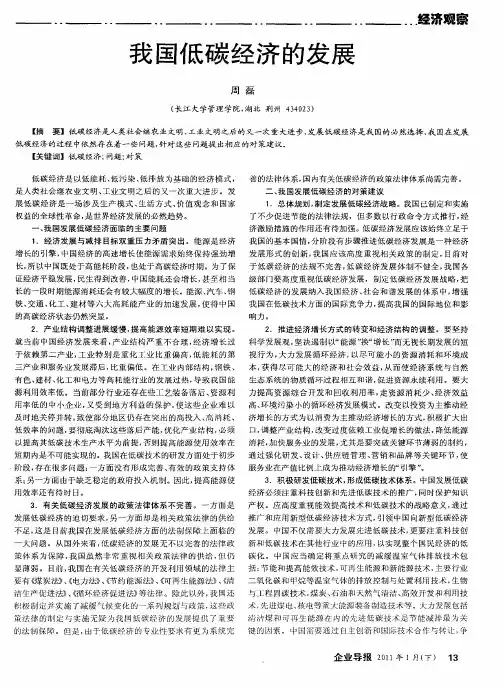
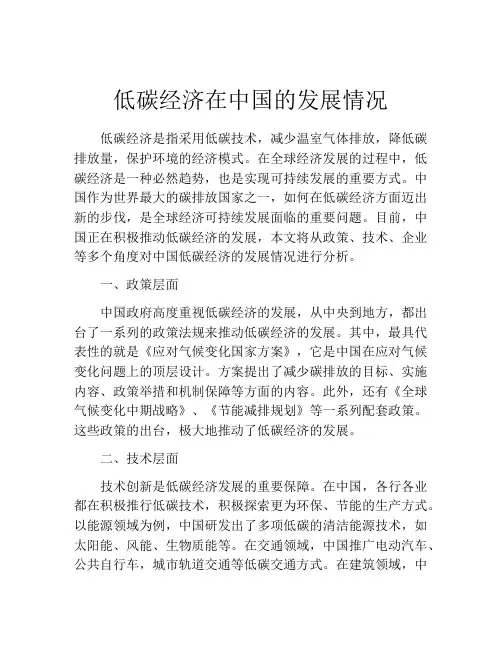
低碳经济在中国的发展情况低碳经济是指采用低碳技术,减少温室气体排放,降低碳排放量,保护环境的经济模式。
在全球经济发展的过程中,低碳经济是一种必然趋势,也是实现可持续发展的重要方式。
中国作为世界最大的碳排放国家之一,如何在低碳经济方面迈出新的步伐,是全球经济可持续发展面临的重要问题。
目前,中国正在积极推动低碳经济的发展,本文将从政策、技术、企业等多个角度对中国低碳经济的发展情况进行分析。
一、政策层面中国政府高度重视低碳经济的发展,从中央到地方,都出台了一系列的政策法规来推动低碳经济的发展。
其中,最具代表性的就是《应对气候变化国家方案》,它是中国在应对气候变化问题上的顶层设计。
方案提出了减少碳排放的目标、实施内容、政策举措和机制保障等方面的内容。
此外,还有《全球气候变化中期战略》、《节能减排规划》等一系列配套政策。
这些政策的出台,极大地推动了低碳经济的发展。
二、技术层面技术创新是低碳经济发展的重要保障。
在中国,各行各业都在积极推行低碳技术,积极探索更为环保、节能的生产方式。
以能源领域为例,中国研发出了多项低碳的清洁能源技术,如太阳能、风能、生物质能等。
在交通领域,中国推广电动汽车、公共自行车,城市轨道交通等低碳交通方式。
在建筑领域,中国大力推广绿色建筑、节能建筑等低碳建筑技术。
这些技术的应用,不仅提高了生产效率,降低了污染排放,还为低碳经济的发展提供了坚实的技术基础。
三、企业层面中国企业在低碳经济的发展中也发挥着重要作用。
越来越多的企业将可持续发展作为企业发展的战略方向,并采取各种措施,减少碳排放,推广绿色产品,开展节能减排等活动。
例如,中石油、中石化等国有企业在向清洁能源转型方面取得了重要进展,企业前沿技术的推广也在不断升级。
同时,许多新兴企业也在创新技术、探索新模式,推动低碳经济的发展。
例如,共享单车、共享经济等新兴业态就展现出了很好的低碳潜力。
四、挑战与展望虽然中国在低碳经济的推动上已取得一定成绩,但也面临着一些阻碍和挑战。
中国低碳经济的发展背景中国是世界上最大的温室气体排放国家之一,但近年来,中国政府积极推动低碳经济的发展。
低碳经济是指在减少温室气体排放的同时实现经济的可持续发展。
本文将探讨中国低碳经济发展的背景,包括气候变化、资源压力和环境污染等因素。
一、气候变化的威胁气候变化是全球面临的重大挑战之一。
过去几十年来,全球气温持续上升,极端天气事件频发,如干旱、暴雨、飓风等。
这些气候变化给全球经济和生态环境带来了巨大的影响。
中国作为世界上最大的发展中国家,其经济和人口规模使其成为气候变化的重要参与者。
中国政府认识到气候变化对国家发展的潜在威胁,因此积极推动低碳经济的发展,寻求更可持续的发展路径。
二、资源压力与能源安全问题中国是世界上最大的能源消费国之一,能源消耗量持续增长给国家的资源供给和能源安全带来了压力。
传统能源的开采和利用给环境带来了严重的污染和破坏。
通过发展低碳经济,中国可以降低对传统能源的依赖,改善能源结构,提高能源利用效率,实现资源的可持续利用。
三、环境污染与健康问题中国在快速发展的过程中付出了环境损失的代价。
空气污染、水体污染和土壤污染等问题日益严重,威胁着人们的生活和健康。
低碳经济的发展可以促进清洁能源的利用,减少大气污染物的排放,改善环境质量,提高人们的生活品质。
四、政策导向与国际合作中国政府高度重视低碳经济的发展,通过制定一系列政策和措施来推动相关产业和企业的发展,例如制定了《中国应对气候变化中长期战略规划(2007-2050年)》等。
此外,中国还积极参与国际合作,加强与其他国家的经验交流和技术合作,共同应对气候变化的挑战。
总结:中国低碳经济的发展背景包括气候变化的威胁、资源压力与能源安全问题以及环境污染与健康问题等。
政策导向和国际合作也为低碳经济的发展提供了重要的支持。
随着中国政府的积极推动和企业的积极响应,中国低碳经济将迎来更广阔的发展前景,为实现可持续发展做出积极贡献。
2024年低碳经济市场发展现状引言低碳经济是指在减少二氧化碳和其他温室气体的排放的同时,实现经济增长和各个产业的转型升级。
低碳经济市场作为低碳经济发展的重要组成部分,正在逐渐成为各国经济发展的新引擎。
本文旨在探讨当前低碳经济市场的发展现状,并分析其中的挑战和机遇。
低碳经济市场的定义和范围低碳经济市场是指在低碳经济体系下,涉及低碳技术、低碳产品和低碳服务的经济活动所形成的市场。
其范围涵盖了低碳能源、低碳交通、低碳建筑、碳交易等多个领域。
低碳经济市场的发展现状国内2024年低碳经济市场发展现状目前,中国低碳经济市场发展取得了一些成果,主要表现在以下几个方面:1.低碳能源市场:随着可再生能源的发展和政策的支持,中国的太阳能、风能等低碳能源市场正在快速增长。
2.低碳交通市场:电动汽车的普及和充电设施的建设,推动了中国低碳交通市场的快速发展。
3.低碳建筑市场:随着绿色建筑理念的普及,中国的低碳建筑市场逐渐兴起,越来越多的建筑项目开始使用低碳材料和技术。
国际2024年低碳经济市场发展现状国际上,低碳经济市场也呈现出良好的发展态势:1.欧洲碳排放交易市场(EU ETS)是目前全球最大的碳市场,为欧洲国家提供了碳排放权的交易平台。
2.美国低碳经济市场发展迅速,尤其是在可再生能源和清洁技术领域。
3.亚洲一些发达国家如日本和韩国也在积极推动低碳经济市场的发展,投资研发低碳技术和推广低碳产品。
低碳经济市场的挑战和机遇挑战1.技术瓶颈:目前低碳技术的研发和商业化仍存在一定的技术难题,需要加大研发投入和技术创新。
2.能源结构调整:低碳经济需要从传统的高碳能源向低碳能源转型,这涉及到能源结构的调整和新能源的开发利用。
3.政策法规:低碳经济市场的发展还需要相关政策和法规的支持和引导,提供市场的可预期性和稳定性。
机遇1.绿色金融机构的兴起:绿色金融机构的发展为低碳经济市场提供了资金支持和金融产品创新的机会。
2.国际合作和经验共享:国际间的经验共享和合作可以加速低碳经济市场的发展,促进资源优势的互补和技术创新的合作。
低碳经济的发展历程低碳经济的发展是指在生产和消费过程中尽量减少温室气体的排放,并最大限度地减缓全球变暖和气候变化的相关影响。
下面是低碳经济发展的历程:第一阶段:环境意识的觉醒(1980年代-1990年代)低碳经济的发展可以追溯到20世纪80年代,当时全球开始对环境问题产生了较大的关注。
环境组织和科学家开始警告人们全球变暖的危险,以及由此可能引发的气候变化问题。
在这个时期,各种环境法律和国际协议开始出现,为后续的低碳经济发展奠定了基础。
第二阶段:低碳经济的概念提出(1990年代-2000年代)在20世纪90年代,随着社会对环境问题日益关注,低碳经济的概念开始在学术界和政策制定者中提出。
低碳经济的概念是基于减少温室气体排放和促进可持续发展的基础上。
这个概念认为,通过合理利用资源和尽量减少与生产和消费相关的碳排放,可以实现经济和环境的双赢。
第三阶段:国际合作和政策推动(2000年代-2010年代)2000年代初,随着气候变化问题日益严重,各国开始加强国际合作,共同解决温室气体排放和气候变化问题。
关于低碳经济的议题在国际间逐渐引起广泛关注。
2005年,联合国气候变化框架公约下的京都议定书正式生效,要求发达国家在未来阶段减少温室气体排放。
此外,一系列国际会议和协议,如哥本哈根会议、巴黎协定等相继出台,以推动低碳经济的发展。
第四阶段:技术创新和应用推广(2010年代至今)近年来,低碳技术的创新和应用广泛推动了低碳经济的发展。
太阳能、风能等可再生能源的发展迅速,为能源的绿色转型提供了可能。
同时,电动汽车、智能交通等创新技术的应用也进一步降低了碳排放。
在政府政策的推动下,低碳城市的建设也取得了突破性进展。
总结起来,低碳经济的发展历程是一个由环境意识觉醒到政策推动再到技术创新的过程。
随着社会对环境问题的关注度不断提高,各国加强合作,并通过国际协议和政府政策推动低碳经济的发展。
技术创新和应用的推广为低碳经济的发展带来了可能。
本科毕业论文外文翻译外文题目:Development of a low-carbon economy in China出处:The International Journal of Sustainable Development and World Ecology作者:Ding DinG, DongBao Dai and Ming Zhao原文:Key words: Low-carbon economy, climate change, carbon emissions, development strategies, ChinaSUMMARYUnder the pressures of climate change, many countries are trying to adapt to a low-carbon economy. In this paper, we review the development pattern of the low-carbon economy of major countries and its impact on the world economy. We then argue that economic development and abatement of greenhouse gas (GHG) emissions in China should be balanced. The challenges that China faces should also be considered carefully. It is necessary for China to find an approach to solve the issues of climate change, which should include new technologies and establishing incentive mechanisms and reform-oriented policies. These guidelines can adjust the structure of the economy and energy use, improve energy efficiency, promote the development of alternative and renewable energy, enhance the potential of carbon sinks, and develop advanced technology to perfect a 'Clean Development Mechanism' and sustainable development through inter-national cooperation. INTRODUCTION:China's current capacity to tackle climate change is relatively low due to its rapid economic development, huge population and coal-dominated energy system. Thus, China faces great challenges in coping with climate change, namely the increasing pressure of CO2 emissions resulting from the high demand for energy in the process of rapid urbanization, industrialization, and globalization. The inter-national community now requests each country to put more effort into controlling climatechanges and mitigating their consequences in order to cope with increasingly serious global climate changes. China's domestic needs and its global climate responsibilities pull the country in different directions and confront China with severe policy challenges (NDRC 2007).Climate change is fuelling a significant renaissance in national environmental movements in Europe. The broad aim of this article is to examine whether it was better to understand the extent to which the 2006 Stem Review on climate change marked a decisive turning point in the UK, or whether it was just another missed opportunity (Jordan 2007). Labelled as the most comprehensive review of the economics of climate change ever produced, the Stem Review was commissioned as part of the G8 Gleneagles Dialogue on Climate Change. The follow-up in terms of new political and policy pronouncements is examined. It is concluded that finding ways to unite domestic and international actions on climate change represents an enormously tricky political challenge for all governments.THEORY AND PRACTICE IN THE LOW-CARBON ECONOMYThe idea of a low-carbon economy is related to the basic material cycles on Earth, especially the carbon cycle and carbon balance. Within a given carbon budget, one may calculate various public and commercial activities with regard to their carbon emissions, and use market mechanisms for trading rights for carbon emissions, either domestically or internationally, through mechanisms in the Kyoto Protocol. A thorough reconsideration of economic and social activities with regard to the control of greenhouse (GHG) emissions may allow a complete transformation of the system in line with low-carbon economic theory, and therefore may provide a sustainable solution for global climate change. In many countries, great progress has been made in scientific research to understand the impact of human activities on carbon emissions in terms of international research on global climate changes (Zhao 2006).International research on the low-carbon economy is currently focused on the following four areas: 1) energy consumption, including trans-forming the energy consumption structure related and rebuilding energy systems into low-carbon systems;2) development of the economy, concentrating on relations between the modes, stagesand developmental speeds of different economic activities and carbon emissions; 3) agricultural production, comprising changes in land use, regulation of agricultural land and changes in agricultural production levels and structure to reduce emissions; 4) analysis of economic risks and research on various countermeasures for reduction of carbon emissions (Zhang et al. 2002).Besides relevant regional and comparative analyses, more and more importance is placed on integrated analyses using comprehensive models and large amounts of data, such as carbon circulation/energy models, dynamic integrated evaluation models and energy consumption models for carbon emission reduction (Wang et al. 2004; Xu’et al. 2006). However, no satisfactory progress has been made in the conversion of energy within the internal elements generating carbon emissions and the interaction of all elements in the carbon emission cycle (ERI 2005).Some developed countries that have complex energy security constraints regard the reduction of greenhouse gases emissions as an integral part of energy strategy adjustment. These countries are attempting to build a low-carbon emission economy by increasing energy efficiency, optimizing energy structures and strengthening R&D. The strategy pursued by these countries is in accord with the UN General Assembly's determination to initiate international climate convention negotiations, which resulted in the Kyoto Protocol and the Montreal Climate Change Conference's decision to start Post-Kyoto Protocol negotiations in December 2005. The European Union has been very active in this process, and in particular the United Kingdom and Germany have made major commitments (Li et al. 2006; Xu 2007).While securing the supply of conventional domestic petroleum energy, many countries are actively developing renewable energy and new energy sources. Many are reconsidering nuclear power development, and adjusting and optimizing the energy structure to effectively reduce the volume of CO2 emitted per unit of consumption. The EU has announced the development goal of developing new renewable energy sources. The USA and Japan have reinforced the role of nuclear power in their energy strategies, after a 20-year history of not building new nuclear power plants. Japan continues to implement plans to reinforce the national power supply with nuclear power and to speed up its development from 29% at present to30% and up to 40% by 2030.It is essential for all countries to create more material wealth with less energy consumption. This will provide economic benefits and is also an important means to reduce CO2 emissions (Zhuang 2005). Japan will raise energy efficiency by 30% by 2030, while the EU plans to reduce its total energy consumption by 20% by 2020, compared with that in 2004. The USA energy strategy will concentrate on production techniques for advanced batteries and vehicle fuels such as cellulosic ethanol and hydrogen, and how to use sophisticated but clean energy technologies, namely clean coal, nuclear energy, solar energy and wind energy. Japan is emphasising research on super-burning, super time and space energy utilization and advanced energy-saving techniques. The EU proposes to develop the world's most advanced energy technologies and accelerate the development of new technologies such as nuclear fusion ITER, new fuel cells, carbon capture and storage, renewable energy and gas hydrates.CLIMATE CHANGE CHALLENGES IN CHINAClimate change is an overall global concern, and energy is the material basis and guarantee for the sustainable growth of China's economy. China is also one of the main emission sources for green-house gases. On the one hand, China currently has a shortage of energy, while, on the other hand, it consumes too much energy, which increases the emission of CO2. Endeavour to control green-house gas emissions and strengthen its sustainable growth capability is both a fulfillment of the requirements of the United Nations Framework Convention on Climate Change and the inevitable result of the full implementation of scientific development concepts in this new situation.Greenhouse gases emitted from energy consumption account for more than 70% of total emissions in China. According to the 'Initial National Communication on Climate Change of the People's Republic of China', China's total GHG emissions in 1994 were 4,060 million tons of CO2 (equivalent to 3,650 million tons net emission), of which 3,070 million tons of CO2, 730 million tons of CO2 equivalents (tCO2e) of methane (CH4) and 260 million tCO2e of nitrous oxides (N2O). A recent preliminary estimate indicated that the emission volume of N2O, CH4 and N2O in China wasapproximately 6.9 billion tons of equivalent weight of CO2, among which, 5.65 billion tons was CO2, 900 million tons was CH4 and 360 million tons was N2O. The total proportion of the emission volume of CO2 rose from 75.6% in 1994 to 81.9% in 2005. CO2 emissions from fossil fuels in China account for about 18% of the world total. CO2 emissions from burning fossil fuels in China were 4.73 billion tons in 2004, 81.6% of that in the USA and 4.3-times as much as in India, accounting for 17.8% of the total 26.6 billion tons worldwide. CO2 emissions from burning fossil fuels in China rose from 10.9% in 1990 to 17.8% in 2004. It is estimated that China might overtake the USA to be the largest CO2 emitter in the world in 2007. CO2 emission per unit of primary energy in China is rising, and is 24% higher than the world average. As carbon content and combustion efficiency varies greatly in different energy sources, different energy structures can be distinguished in CO2 emissions. CO2 emitted per unit of primary energy in China was 2.94 tons per ton petroleum, 24% above the world average of 2.37 tons CO2/ton petroleum, 18% higher than in the USA (2.49 tons CO2/ton petroleum) and 1.52-times that of India (1.93 tons CO2/ton petroleum). From 1990 to 2004, the intensity of CO2 emissions from primary energy consumption grew by 12.9% in China, while it declined by 0.7% in the USA.The development history and tendency of all countries indicates that per capita CO2 emissions and per capita energy consumption are closely related to economic growth. At the current technical level and in the consumption mode, reaching the development level of industrialized countries requires that the per capita energy consumption and per capita CO2 emission reach very high levels. There is no world precedent for low per capita energy consumption and CO2 emissions combined with high per capita GDP. The international community's negotiations on reduction and restriction of GHG emissions can never be simple, as each country is striving for development space and options for development pathways. With its large population base, China still faces a long-term development task to accomplish its industrialization and urbanization . As the economy grows, energy consumption and emissions of CO2 will continue to grow, so reduction and mitigation of GHG emissions is driving China to explore new types of production and consumption (Zhao 2006).China is one of the few remaining countries using coal as its major energy source. Coal accounted for 67.7% of primary energy consumption in China in 2004, but only 27.2% globally in the same year. A unit of coal emits 1.36-times as much CO2 as that emitted by petroleum, and 1.61-times as much as that emitted by natural gas. Adjustment of the energy structure is restrained to some extent by the composition of available energy resources, and improvement of energy efficiency confronts a scarcity of technical and financial resources. Thus, the, coal-focused energy resource structure and consumption structure in China cannot change fundamentally in a short time, forcing China to face more difficulties than more developed countries in adjustment of the energy structure and reduction of per unit energy emissions.Old energy production methods and technologies in China are the main barriers leading to inefficiency of energy consumption and higher emissions of GHG. Furthermore, China lags behind developed countries by about 10-15 years in energy exploration, supply and conversion, energy transmission and distribution techniques, industrial production techniques and terminal use techniques for other energy sources. Conventional technologies are the mainstay in China's key industries. For example, production of a ton of steel consumes between 700-800 kg of standard coal. Lack of sophisticated technology and use of many out-dated techniques reduce China's energy efficiency by 10% compared with developed countries. In other words, China's unit energy consumption is about 40% higher than that of other developed countries. Dealing with the challenges of climate change will eventually depend on development of new technologies. China is currently constructing large-scale infrastructure for energy transformation and energy-efficient buildings. Failure to acquire advanced technologies beneficial for reduction of GHG will lead China to be a still higher GHG emitter for several decades, which, in turn, will create more serious challenges in handling climate change.After China became a net petroleum importer in 1993, its imported petroleum has grown year-by-year. In 2006, China's net annual import of petroleum exceeded 160 million tons, or a dependency on foreign imports of nearly 50%. In addition, import of natural gas has also risen dramatically, but this promotes adjustment of China's energy structure and reduces emissions of several pollutants and GHG.Considering China's huge environmental pressure in energy production and consumption and the rapid growth in energy demand, adjustment of energy structure and increase of high-quality energy imports are two further important pathways. The rapid growth of petroleum and coal imported by China will impose great challenges to China's energy security and also increase pressure on international energy markets.CHINA'S DEVELOPMENT PRINCIPLES AND CONCEPTS FOR A LOW-CARBON ECONOMYBy reviewing the environmental protection history of major countries and analysing their energy strategies, it can be seen that environmental problems have occurred during development in all countries. Developed countries have used new laws, regulations and economic instruments to resolve problems of domestic environmental pollution, ecological destruction and global climate change. With industrialization , urbanisation and modernization , China's consumption of energy will continue to grow rapidly. The development and use of energy will have an increasing impact on the ecological environment, compelling China to face dual challenges of both traditional environmental problems and climate change. China will achieve its sustainable energy development goal only if environmental protection is central to its strategies, and if it builds clean, highly efficient, environmentally friendly and beneficial energy systems appropriate to its economic development stages.Policy tools not only help to implement a low-carbon economy but also to diversify and coordinate policies. China has stipulated and implemented regulations and rules to promote energy saving at various levels. However, we should promote participation and cooperation of 'intermediate powers', including industrial associations, consultant organizations, investment companies, scientific research institutes and the media to better coordinate relations between state-owned and other enterprises. China should endeavour to send a clear message to such groups through the coordination of policy tools in order to help decision-makers to understand the challenges and opportunities that the low-carbon economy will bring. Policies to promote the development of a low-carbon economy are gradually being brought into China's national planning and policy and should be implemented in stages, to avoidlarge impacts on the economy. Active and conscious consideration of low-carbon factors in pollutant control and regulation will enable us to resolve problems of pollutant emissions and achieve low-carbon economic growth.The general concept of China's low-carbon economic development model is to accomplish industrialization by 2020 and modem economic development around 2050. The prerequisite of this concept is to guarantee the construction of a better-off society throughout China. To achieve this, we must take active measures, such as revision of economic and social consumption models, development and popularization of advanced energy-saving technologies, expansion of renewable energy and advanced nuclear energy technologies, optimization of energy structure by applying high-efficiency, clean and low-carbon emission coal technologies and hydrogen technology, combined with ecological environmental protection. These measures will achieve the low-carbon economy and gradually build the system and mechanism for reduction of emissions of CO2 and other GHG (Jiang and Yao 2003).APPROACHES TO REALIZE LOW-CARBON ECONOMIC DEVELOPMENT FOR CHINATo achieve low-carbon economic development in China, we should consider our national situation and develop our potentials in terms in the areas described above and through international technological and economic cooperation. As a coal-focused energy consumer, China suffers from the resulting complex environmental problems, which are constantly worsening China's ecological environment. To construct an energy-saving and environment-friendly society and revolutionise the traditional extensive growth, China should optimize industrial structures and actively develop high value-added and environmentally friendly high-tech industries and service sectors during its industrialization. It should be emphasized that reform of the chemical industry and encouraging enterprises to install and operate environmentally friendly and energy-saving equipment and improve management and energy consumption efficiency can lead to a low-carbon economy (Lu and Wang 2003). China should speed up development of water, natural gas and renewable energy resources for the home, while encouraging the safe development of nuclear power. Based on current national coal usage, the basic energy supply will not changeradically until 2030. It is our special task to optimize terminal energy and resolve pollutant emissions in energy consumption (Pan and Zhu 2006; He et al. 2006).In spite of a recent decline in energy intensity, China still has a large gap in when compared with developed countries. The integrated energy efficiency of China is currently about 33%, 10% lower than that of developed countries. China's unit energy consumption of major products in industries such as electric power, steel and iron, nonferrous metals, petrochemicals, construction materials, chemicals, light industry and textiles is 40% higher than that of more advanced countries. The integrated energy consumption per unit products for steel, cement, paper and cardboard in China is, respectively, 21%, 45% and 120% higher than in more advanced economies. Oil consumption by vehicles in China is 25% higher than that in European countries, and 20% higher than that in Japan. The energy consumed to supply heating per unit floor space is two to three times as much as that of the developed countries with similar climate conditions. China's recovery ratio of mineral resources is 30%, 20% lower than that of developed countries. Progress and innovation in energy technologies is essential to mitigate emissions of GHG. The developed countries all concentrate on adoption of new energies, R&D for low-carbon fuel, cleaning of traditional fossil fuels and advanced power generation techniques to realize low-carbon economies. China should develop new energy technologies such as 1) production of ethanol from cellulose and hydrogen for vehicle use, 2) advanced power generation such as clean coal, nuclear, solar and wind energy, 3) advanced techniques such as carbon capture and storage, and 4) renewable energy.China should apply economic policy measures, including taxes, pricing and revenues, and concentrate on designing energy-saving and renewable energy, new energy and energy-consumption products to prevent pollution. We should also develop financial incentive mechanisms to encourage investment and financing in energy fields. We should revolutionize the current energy pricing mechanism and price administrative as well as price relationships among energy products, which do not benefit or adapt to environmental protection. Consequently, energy structure will be successfully adjusted and the dominant energy-saving priority strategy in the market will be set up. We should strictly regulate energy consuming projects andequipment into the market, and replace old techniques and equipment, therefore promoting the environmental protection level of the energy consumption system in an all-round way.Although each country has a different understanding of climate change and advances different ways to cope with it, effective cooperation and dialogue are required to deal with challenges produced by climate change. The growth of energy demand and GHG emissions is mostly attributable to developing countries, which are restricted by their economic strength, low technological level and relatively deficient technological R&D capability. To achieve the common goal of global sustain- able growth, developed countries are expected to provide funds for and transfer technologies to developing countries. In addition, China has the responsibility to accelerate its own technological transfer from developed countries.CONCLUSIONSIn the low-carbon economic development mode, carbon emission should be used as a standard to check the validity of any activity. The government, enterprises and individuals should restrict their actions and conduct their life in a much greener and more environmentally friendly manner. Low-carbon and non-carbon energy resources will be largely applied in future. Energy efficiency will be enormously raised and green consumption will be advocated. Carbon emission reduction will be used as a commodity that can be freely transacted in the market. We believe that the building of the new low-carbon society and economic entity will finally realize zero carbon emissions and, therefore, radically restrain climate change.本科毕业论文外文翻译外文题目:Development of a low-carbon economy in China出处:The International Journal of Sustainable Development and World Ecology作者:Ding DinG, DongBao Dai and Ming Zhao译文:中国低碳经济的发展关键词:低碳经济,气候变化,碳排放,发展战略,中国概要:根据气候变化的压力,许多国家正在努力适应低碳经济。